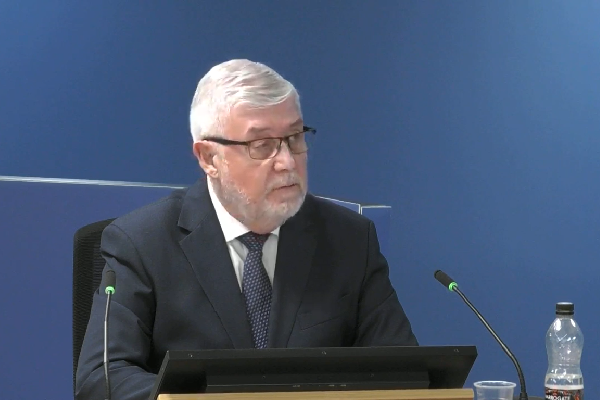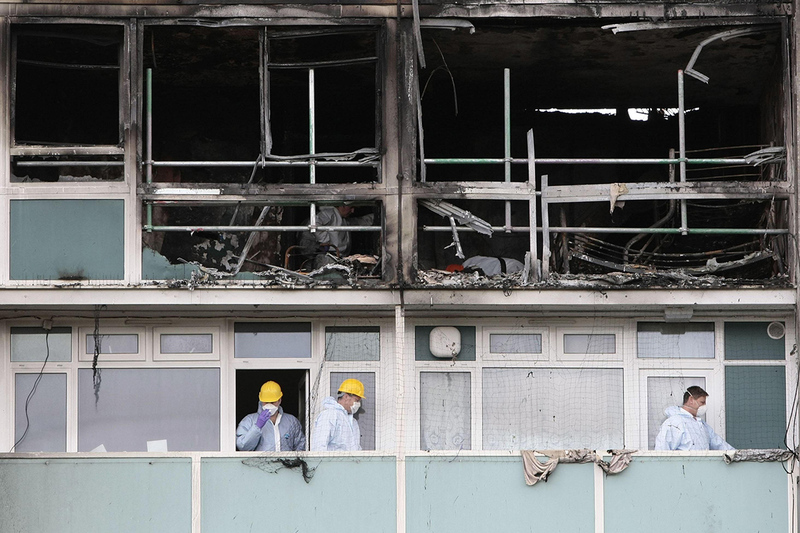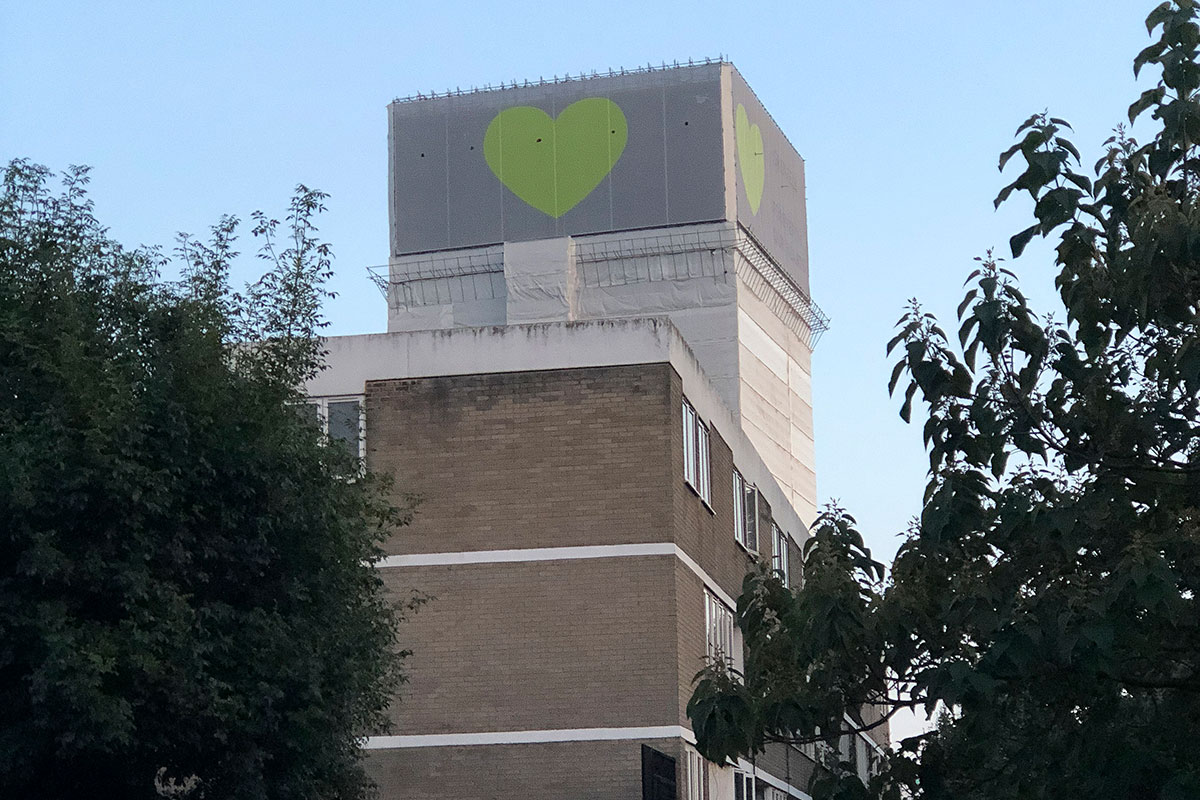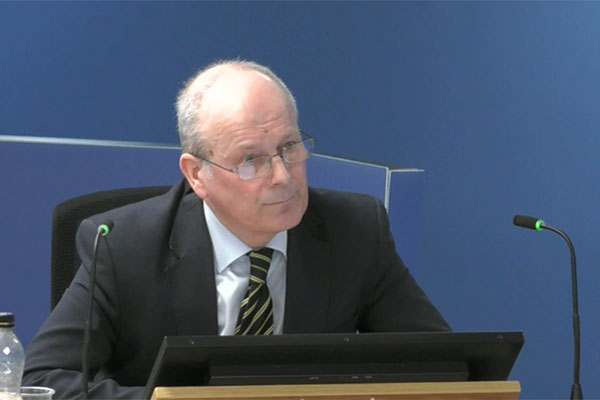Senior government advisor wrote report saying external fire spread ‘not significant’ at Lakanal House
The government’s senior fire advisor wrote a report weeks after a fatal flat fire in 2009 which said external fire spread was “not seen as significant” and that combustible panels on the buildings walls “did not appear to burn unduly”.
Sir Ken Knight’s early report into the Lakanal House fire said the external spread of the blaze, which affected flats on eight floors of the building and killed six people, was “not seen as particularly unusual”.
Later investigations would reveal that the panels were made of a highly combustible cladding material and combustible foam insulation – well below the minimum standards.
Lawyers for bereaved and survivors have previously criticised this report, saying it “raises the spectre of a deliberate cover−up, given Knight never sought to correct his misleading report”.
The inquiry saw today that a private report by an architect, compiled for residents and sent to Sir Ken days before he submitted his version to ministers, pointed to these panels as having caused the spread.
Sir Ken had been asked by the secretary of state, Labour’s John Denham, to undertake an “independent overview of the investigations into the [Lakanal] fire and to report back as a matter of urgency” following the blaze on 3 July 2009.
At the time, he was the government’s chief fire and rescue advisor, a role, graded as equivalent to director level in the civil service, which saw him advise ministers and officials about the English fire and rescue services.
He was asked by Mr Denham to identify any emerging fire safety issues, lessons to be learned and whether official guidance remained appropriate and asked to report back within four weeks.
“Do you think that was sufficient time to allow you to investigate properly?” asked counsel to the inquiry Andrew Kinnier QC.
“It was never intended to be a full investigation because, as you rightly suggest, 28 days was insufficient to do that. But it was to give some early impressions of early discussion with those involved in the fire,” he replied.
Sir Ken’s report said that “from initial observations, the… infill panels did not appear to burn unduly”.
It added: “From the early findings, the issue of external fire spread is not seen as significant.”
“It wasn’t seen as a significant external fire,” he said, when asked how he reached this conclusion. “It [the fire] wasn’t caused by the external wall itself.”
The inquiry has previously heard that a separate investigation into the fire being carried out by the Building Research Establishment (BRE) was ‘shut down’ by government official Brian Martin on 20 July 2009, just weeks after the fire.
Sir Ken, who also told the inquiry that he “knows and knew Brian Martin extremely well”, said he did not believe he was aware of this decision.
The inquiry has previously seen that Mr Martin also sent emails in the immediate aftermath, saying he “did not think there’s any need for changes” to official guidance resulting from the fire.
“You didn’t ask for investigations to be carried out to determine the extent to which external window panels promoted downward fire spread. Was that a thing which ought to have been done because of the importance of identifying risks in other buildings?” asked Mr Kinnier.
Sir Ken said that his work had been “overtaken by a police investigation” and he “assumed this would fall into the police remit rather than my own”.
The inquiry saw that two days before Sir Ken’s report was sent to ministers on 30 July 2009, he was sent a report by architect and safety campaigner Sam Webb, which had been prepared on behalf of residents.
In it, Mr Webb wrote: “It is not what caused the fire but the way and speed with which it developed that should be considered. It took the fire brigade by complete surprise both in the way it went up and DOWN the building.”
He added that he believed panels on the outside of the building aided the fire spread, writing that his investigations showed they were made of combustible plastic.
“I’m surprised that such a material was approved for use in such large quantities on the facade of the building,” he wrote.
“Why was that analysis of the cause of the fire spread not included in your final report?” asked Mr Kinnier.
Sir Ken said Mr Webb’s report had been received “too late”, after his version had “gone to print”.
“Is that the type of document which would have prompted you to have drafted a postscript, for example, to be submitted to the secretary of state?” asked Mr Kinnier.
“No, it wouldn’t have because it didn’t materially change my report in any significant way,” said Sir Ken.
As the inquiry has previously seen, Sir Ken was sent a letter in December 2009 by Ron Dobson, commissioner of the London Fire Brigade, which said testing on the panels carried out for the police had shown they were combustible and suggested “a warning to be given to housing providers” to check other blocks.
On the same day, Sir Ken sent an email to officials at the Department for Communities and Local Government (DCLG) telling them the police investigation had showed the panels “enhanced the vertical spread of fire from the flat of origin and may have contributed to downwards fire spread”.
He told them Mr Dobson wanted to issue a warning, but said the police were concerned that early disclosure of the details might “prejudice” their investigation. He added in the email: “I expressed a view that it would be premature to advise other authorities (or the public) of a potential risk without being aware of the facts and implications of the[...] findings.”
The email to officials prompted a chain where one civil servant, Anthony Burd, warned the department needed to be “very careful” to avoid “setting the hares running”.
Another said such a warning would be “critical information in housing terms” and “we would need to assess what is to be made public”.
Days later, Sir Ken responded to Mr Dobson, writing that: “It was felt that there was insufficient information at this time to warrant alerting housing authorities and/or property owners as to the specific matters raised.”
Sir Ken said specific detail could not be released without jeopardising the police inquiry.
He told the inquiry a generic letter was sent “not specifically talking about those panels, but bringing to the attention of housing authorities and fire and rescue service such risks in high-rise buildings”.
Sir Ken, who has chaired the expert panel advising government on fire safety matters since the Grenfell Tower fire, will continue giving evidence tomorrow.
Earlier, Bob Ledsome, the former deputy director of building regulations, completed his evidence which began last week.
Mr Ledsome was asked about an exchange of emails between Steve Evans, head of technical operations at the National House Building Council (NHBC), and senior official Mr Martin in July 2014.
Mr Evans had told Mr Martin combustible insulation made by Kingspan was installed on many high-rise buildings due to a third-party certificate which erroneously suggested it was appropriate.
The inquiry saw that Mr Martin forwarded the email to Mr Ledsome, writing: “It would appear that a number of tall apartment buildings have been insulated using combustible insulation materials when perhaps they shouldn’t have been.
“NHBC are aware and working with the manufacturer to see if this is a problem or not.
“If it is a problem, some blocks may need to have their cladding replaced (possibly a lot of them).”
No action was taken by the department to establish the safety of buildings with ‘K15’. A small amount of the product was ultimately used in the cladding system on Grenfell Tower.
“There are legitimate questions as to how far we and maybe the NHBC were accepting what Kingspan were telling them and then us through the NHBC,” said Mr Ledsome. “With hindsight, perhaps we should have done more inquiries of our own bat rather than relying on third-party communications.”
Mr Ledsome was also asked about revelations which emerged yesterday that Mr Martin was warned about the widespread use of the highly combustible aluminium composite material (ACM) cladding in the UK in February 2016.
A cladding supplier had emailed him to describe his “grave concern” about the material that the number of buildings where it was installed in the UK were “many and growing”.
“This was, I think you must accept, a very large red-alert situation with a life safety matter that needed urgent attention,” said Richard Millett QC, counsel to the inquiry.
“I would accept it was a serious matter, yes,” said Mr Ledsome. He said he “could not recollect” the warning being drawn to his attention.
“Can you think of a reason why Mr. Martin would have kept this red hot information to himself?” asked Mr Millett.
“It would be wrong of me to try and speculate,” said Mr Ledsome. He added that Mr Martin may have thought the issue could be addressed when official guidance was next issued.
At the end of his evidence, Mr Ledsome said he “bitterly regretted” not ensuring building regulations were given more attention from ministers within the department before Grenfell.
“It was my job, part of my role, to ensure that building regulations were not always at the back of the queue for resources, for priorities,” he said.
Mr Ledsome added: “It is bitterly regrettable for me because, who knows whether it ultimately impacted precisely what happened at Grenfell, but it will be forever on my conscience that I failed on that.
“That was my role and I can’t say that I discharged that as I would have wanted to.”
He added: “It will be forever on my conscience that perhaps my best was not good enough.”
The inquiry continues.
Sign up for our weekly Grenfell Inquiry newsletter
Each week we send out a newsletter rounding up the key news from the Grenfell Inquiry, along with the headlines from the week
Already have an account? Click here to manage your newsletters













